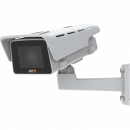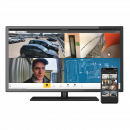
Albert Einstein Hospital deploys pioneering video surveillance system in the hospital sector.
The largest hospital in the Southern Hemisphere has adopted strict access control in all seven of its units using 1,250 Axis cameras.
Mission
The Albert Einstein Hospital is considered to be the most advanced hospital in the Southern Hemisphere. Its units, mainly in the São Paulo Metropolitan Region, employ 12,322 people (including contractors) and receive about 4,000 visitors a day. As part of its network expansion plan, another unit has been opened in São Paulo (Perdizes Higienópolis). This new facility also placed increased demands on safety for patients and hospital staff and on safeguarding its assets. The hospital needed stricter controls on who was entering and leaving.
Solution
The hospital administration decided to adopt a more modern method of access control in all its units. This is the first time a hospital in Latin America has implemented a system combining access control, video surveillance, fire prevention and detection, and building automation. Einstein’s seven units employ 1,250 Axis cameras to control 450 access points.
Result
The project was delivered under a turn-key contract and went into operation automatically at the end of the installation, launching a new concept of security for the hospital area. These investments follow the trend toward a greater control of the flow of people inside hospitals. One of the most immediate results is the greater sense of security patients and employees feel. Other impacts are being seen over the long term: crime prevention, identification of suspects, and asset preservation.
Einstein only works with cutting-edge equipment, both in the medical area and in other hospital departments; that is why we chose Axis, a company that is in sync with our goals.
User registration
Users can now only gain access once they are registered. On passing through the turnstile, Axis’ high-performance cameras record an image of the user’s face with highresolution imaging. After making this complete record upon entering, all user movements through access points, such as doors, turnstiles and gates, are tracked by other Axis cameras. The project includes 450 access points.
The control room operator only needs to enter the user’s name into the system to get all their entrance images, viewing details about their face and general appearance, and all their subsequent images—where they go, what they are carrying, if they were being accompanied, and what time they passed each checkpoint.
Discreet observation
Since hospitals have specific needs, the project underwent some adaptations. Camera position, for example, is not so apparent as to make people feel under suspicion, but the cameras still need to be visible enough to deter criminal actions. One of the project’s design challenges was to carefully balance the need for camera coverage against the need to respect the patients’ and visitors’ privacy and feelings. In short, the system had to be very well designed so that it did not seem threatening, but was able to dissuade malicious action while maintaining full respect for privacy.
“The Axis cameras surprised us in a positive way, because they provided different applications that the old analog cameras didn’t offer”, said Dov Smaletz, Albert Einstein security manager. “Because they are 100% IP, they offer the resources for intelligent monitoring.”

The system has both passive and active features, and notifies control room staff when a person or a movement is captured by a camera.
The system is 100% PoE (Power over Ethernet) and has roughly 36 terabytes of storage space, enough for two weeks of images, all centralized at the Morumbi unit, where a 100% RAID 5 solution vastly improves data access. Due to the quality of the cameras and ongoing maintenance services, the system ensures nearly 100% availability.

Ready for the future
Axis’ integrator partner Servtec developed and installed the project and it is also responsible for future maintenance. This maintenance even can be done with the help of images from the security cameras themselves, an example of the large degree of integration of the project.
“The implementation was considered complex because it’s the first hospital to oversee all people entering and leaving the complex using turnstiles,” said Alexandre Gushiken, Servtec sales manager.
Products & solutions


